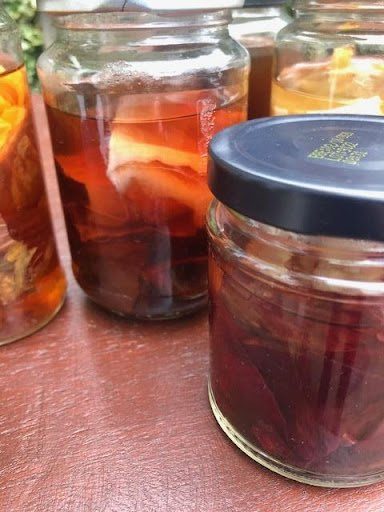At this time of year the carefully stored harvest of last year’s dye plants is beginning to dwindle. However there are other possibilities and some very close at hand. Waste from our kitchens can yield a wide range of results and can be a great way to begin to explore the exciting pigments that can be caught before they decompose in the compost bin.
For me the onion skin is the leader of the pack when it comes to dyeing from waste. Red and brown give delightfully different results. It can take a while to collect enough but the skins will keep indefinitely and can also be dried out after dyeing for future projects. The skins contain tannin and therefore can be quite effective without a mordant. You can find a full recipe here

* If you are not familiar with the basics of natural dyes, we recommend you to read our Natural Dyeing Notes here




Avocado pits and skins are another delight to work with. You can get a very rich dye bath from 5 or so pits. To maximise the amount of colour – Gently heat in sufficient water to cover the pits and skins, and then slowly heat till just below simmer. Then maintain that heat until the water turns a deep pink and pour into a bucket. Do this, successive times until you have at least one litre of dye. Strain into dye pan and add sufficient water to allow your cloth or yarn to float freely. The dye can be used hot or cold.

Some kitchen waste doesn’t require heat to turn into dye. Examples include red cabbage leaves and black beans. For example, you can chop up and freeze the outer leaves of red cabbage then submerge them in warm water and watch the colour flood out. This experiment can be made even more exciting by altering to pH which can be simply done by the addition of bicarbonate of soda to increase alkalinity or white vinegar to lower the pH and make the solution more acid. Sadly, it is hard to retain the colour in the bright liquid and it will often result in a range of grey shades.


The liquid left after you have soaked black beans (before cooking them), provides another source of dye, similar to red cabbage, but in my experience, a little more fast and especially on wool. I usually leave the beans in water overnight or up to a maximum of 16 hours – any longer and your beans will be tough when you cook them. Then carefully strain off the liquor aiming to leave most of the sediment behind. Submerge your wetted prepared fabric or yarn into the cold liquid and leave to soak for as long as possible.


However, if you wish to experiment without turning your kitchen into a mini laboratory, you could try the following process – the simplest way to extract colour from plant material. Fill a jar half full with leaves, berries or clean peelings and then fill with boiling water and leave in a sunny position. You could add a scrap of cloth or yarn and see if there is any impact. This is a great activity to do with children or may just whet your appetite for more dyeing adventures with more traditional techniques.


At Sewing Café Lancaster we are committed to promoting natural dyes as a viable alternative to chemical colour. We have found the growing of dye plants enormously satisfying as well as utilising plant material that would usually decompose taking their beautiful pigments with them.

Notes prepared by Katrina Barnish for Sewing Café Lancaster/// sewingcafelancaster@gmail.com